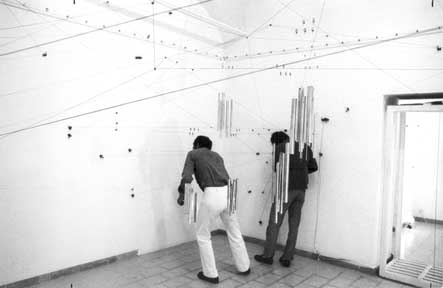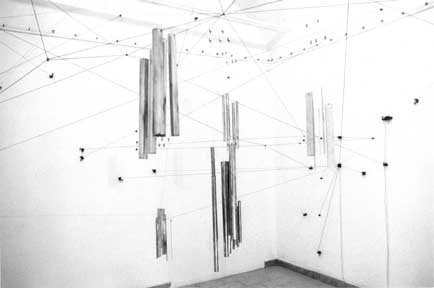





Magic Carpet: a sound installation by Paul Klerr and Alvin Curran - Galleria Mara Coccia/Arco D'Alibert, Rome, 1970. Brief recording available on CD from Pogus Productions (2008), longer recording on vinyl from Die Schachtel (2010). Listen to an excerpt.
A NOTE: "The Magic Carpet happened quite naturally by chance. I saw a room of Paul's string structures in his home and immediately suggested to him that the whole thing should be made to sound - our collaboration was born. Fresh from a USA tour with Musica Elettronica Viva, I had been thinking about making environments of suspended-sonorous-objects, so I added the chimes, which further transformed the space into a musical instrument. We gave no suggestions or rules. The strings and chimes, "harps and guitars," are there to delight the eye and ear - to be discovered, viewed, and played at will in an effort to bring people into harmony with the space itself and with each other." (Alvin Curran)
PARTICULARS: Two basement rooms of the Gallery Arco D'Alibert (Rome, Italy) were threaded by about 300 meters of colored strings in cotton, wool, gut, nylon and steel, creating a web of geometric patterns which changed with the viewer's perspective. Eighty metallic sliding intersections enabled the viewer/participant to modify the structure at will. From an independent set of strings, ten groups of chimes of about 5 elements each in bars and tubes of hard and soft aluminum, brass and steel from 8 to 35 cm. in length were suspended. A wooden frame and sound box was fitted into the passage-way betwene the rooms and supported 35 steel strings maintained in tension by piano tuning pegs. The whole formed a kind of walk-through harp. There were no chimes in the first room and only one waxed wool string, if rubbed, was made to sound. In corners of the second room strings converged into small metallic "sound boxes" which also housed contact mikes. The sounds of these "wall-guitars" as well as those of the "harp" were picked up by eight mikes in all, amplified and heard on speakers in two other rooms in the gallery. No conscious attempt was made to tune thesse instruments nor indicate what to do with them. The public was quick to move from the novelty of making sounds to the pleasure of making its own "public music."
A COMMENT: "...You walk into all this as if into a cobweb that is a musical instrument - you are inside an aviary for sound. Anyone may be lifted out of his daily life, become an artist or musician by moving and touching, creating his own cocoon of spaces, making his own amplified electronic music with depths and chimes inside the taut humming texture." (The International Herald Tribune October 10-11, 1970)